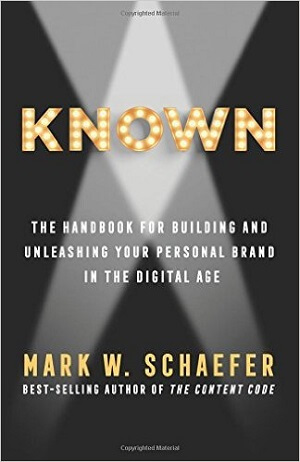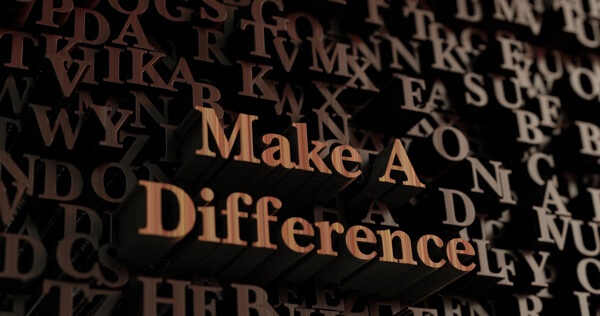Do you want to be recognized as an expert in your field?
Wondering how to make a name for yourself?
To explore how to become known, I interview Mark Schaefer.
You’ll discover the four things it takes to become known.
Listen Now
Listen now: Play in new window | Download
Here are some of the things you’ll discover in this show:
Thought Leadership
How Mark Became Known
Before Mark launched his business, he was a global director of ebusiness at a Fortune 100 company. He had won a bunch of awards and had seven patents, a big global team, stock options, and a company car. After he left that job to start his business, Mark realized everything that he was known for at his previous company no longer mattered. He thought he was known, but he wasn’t.
As Mark grappled with being the go-to guy for nothing, he learned the only thing that matters in terms of your online presence is to be known. Being known isn’t about being famous, but having an appropriate digital presence to help you achieve your goals.

Mark says your online presence should help you meet your goals.
Mark says that building expertise and becoming known is a process. Nine years ago, as Mark started to teach and write for his own business, he struggled. Like everyone else, he started at the bottom. For instance, when Mark started blogging, he didn’t know anything about it. Later on, Mark wrote a book about blogging. When he started consulting, he knew very little about it, but now he consults for big companies.
Mark emphasizes that to start, you don’t have to be an expert. You only need to be open and willing to learn continuously.
I ask Mark what helped him become known again in the second phase of his career as he was building his own business. Mark says his goals, one of which was speaking at Social Media Marketing World, helped, but enjoying the journey was also important because becoming known takes time.
Mark says some people set milestones that unknowingly let other people validate their work. However, as he was interviewing known people for his recent book, they often mentioned the positive impact they have on others. Mark believes this sense of mission is important because it defines who they are from within and motivates them as they put in the time necessary to become known.
Listen to the show to discover how many years it takes to become known.
What Prompted the Book
Mark explains the two seeds that led to him write KNOWN.

KNOWN by Mark Schaefer.
As research for his last book, The Content Code, Mark interviewed Jay Baer. They debated whether just anybody can become known or if you need a certain “it” factor. For three and a half years, this question stayed with Mark and he began wondering whether becoming known involved a process that he could define.
The other seed, Mark explains, came from his conversations with consulting clients. People from all over the world ask Mark questions like, “How do I get in a position where I can write a book someday?” “How do I get in a position where I can be a speaker someday?” “How do I get appointed to a board?” “How do I attract more clients in my industry?” “How do I become regarded as a voice of authority?”
Mark found himself giving the same answer over and over again: “To do that, you have to be known.” He didn’t want to give that answer without telling people how.
Although Mark had a framework for the answer, he spent 15 months elaborating on and refining it. As Mark interviewed inspirational authorities in all different fields (education, real estate, construction, banking, art, music, finance, etc.), he discovered everybody did the same four things.
Mark and I discuss why we both believe anyone is capable of becoming known. However, Mark emphasizes that you have to be disciplined, committed, and work hard to execute the path.
Listen to the show to hear Mark’s story of Dr. Alice Ackerman, who worked to become known in order to improve children’s health in her rural community.
The Four Common Elements
Mark shares the four things all known people do to become known.
1. Find a sustainable interest. Although most self-help books emphasize “finding your passion,” Mark says that research doesn’t support that idea. Georgetown University professor Cal Newport showed that the need to follow your passion is really a myth.
Mark’s findings show that whatever you do has to last a long time, affect a critical mass of people to make a difference, and be something you love. However, most successful entrepreneurs may or may not focus on their passion. Sometimes a hobby is just a hobby.

Choose something that affects a critical mass of people to make a difference.
If you’ll be working on something for a good part of your life, Mark adds that you need a plan; you can’t just follow a dream blindly. Mark includes exercises in his book to help people find a sustainable interest and make sure enough people need what you want to offer.
2. Find your space. After you determine what you want to be known for, you need to figure out where and how to tell your story. In a noisy world crowded with competition, Mark says this step is critical. Most people who struggle to become known without much success have made the wrong decision about their space.
In the book, Mark spells out eight different ways to find your space, even if it’s very crowded. Sometimes you find your space by developing your story in places that others in your field have ignored. For example, Suzy Trotta is a real estate agent who became known in a mid-sized Tennessee county with 6,000 real estate agents. However, Suzy has become hugely successful using her unique, quirky, funny voice, and publishing her content on Instagram and Twitter, where other real estate agents usually weren’t.
Other times, you find your space by developing a distinctive angle on your subject matter. Mark mentions Isadora Becker, who became known in the extremely crowded video food blogging space. In her videos, she makes famous recipes from movies and TV shows and dresses up like the characters as she makes them. In other words, she created a niche nobody else was occupying.
3. Determine content. Next, you need to choose the type of rich content you’ll create, whether it’s written, audio, video, or images. Mark says people get overwhelmed by thinking they need to be everywhere. Instead, you can focus on precisely the right kind of content for you. In KNOWN, Mark has exercises to help you determine what type of content suits you best and start creating it.
I mention that creating content seems essential to becoming known and when people think about whom they look up to, those inspiring people are likely all creating content. Mark agrees and says that creating content is also a lot of work.
For example, Zander Zon, one of Mark’s interviewees, makes a career out of playing the bass on YouTube by himself. He told Mark the reason he (or anybody) became known on YouTube (or another social channel) is because he was willing to put in an insane amount of work.
Because of the work involved in creating content, Mark also addresses whether it’s the right time to work toward becoming known. People looking to get known need to be willing and able to put in a certain number of hours a week for a few years before they reach a tipping point.
Mark emphasizes that your content needs to communicate your message well and that the time you put into becoming known through your content also helps you become better at creating that content. As you choose what content to create, you need to look at the open holes and what the competition is doing. However, Mark thinks creating something that you love is equally important because your excitement will come through in your content.
After you master one type of content such as writing, you can add something else like video to your content mix.
4. Develop an audience. Mark says your content becomes valuable only when people see and share it. With the web and social media (as opposed to print ads, brochures, and direct mail), you can know whether people are reading, responding to, and signing up for your content and you can use that data to build and engage with your audience.
Mark finds that people who successfully build their audience have a strong commitment to that audience. Those who become known put their audience first, no matter how big they become.
For example, a travel blogger in the United Kingdom (Mrs. O Around the World) told Mark she put the brakes on her audience development. She doesn’t want her blog to get much bigger, because she wants to still be able to engage with her community members.

Travel blogger Ana Silva O’Reilly built an engaged audience along with her blog, Mrs. O Around the World.
I ask Mark whether a certain audience (Twitter followers, YouTube subscribers, email subscribers) is more important than another. He says that although no single solution fits everybody and the one you choose depends on whom you’re trying to reach, Mark would choose Twitter if he had to pick one platform.
Mark says Twitter has received some bad press because it isn’t meeting Wall Street’s expectations. However, 330 million people use and love Twitter, and it’s part of the popular culture. Tweets appear on TV shows and the news all of the time. Beyond these basics, Mark finds Twitter appealing because you can look for opportunities to engage with people even if they don’t follow you back. Also, many third-party utilities help you find people who are relevant to you.
Mark compares Twitter with LinkedIn and Facebook. He says you can connect with people on LinkedIn, but because people aren’t chatting much, LinkedIn doesn’t have as many opportunities to engage with your audience. Mark thinks that because Facebook is primarily friends and family, most people don’t want new business connections on it.
Listen to the show to learn how Mark and I started as writers and expanded our content and audience.
How to Determine if Your Content Is Working
Mark says the process of becoming known occurs in phases. In the first year, you see signs of increased awareness such as social media mentions and increasing followers.
In the second year, as you consistently create content, look for higher-level signals such as connections from influencers and a growing subscription rate (like on your YouTube channel or podcast).

A growing follower base lets you know the content you create is working.
Finally, keep your eye on your business goal. Track everything that could be a leading indicator that you’re making progress. An interview for a podcast is a sign you’re moving in the right direction. If someone wants your input for a blog post, a white paper, or an ebook or for you to speak at a local club, those are positive signs.
When Mark asked each person he interviewed for the book to share an encouraging message for someone who’s working to become known, almost everyone responded with a version of consistency, resilience, or tenacity. They said the saddest thing is to watch people make progress but not recognize it, and quit too soon.
People assume those they admire made it in a year or were an overnight success. Mark guarantees that’s not true. Known people put in the work and you’ll have to do that, too.
Listen to the show to hear why you need to continue creating content consistently even after you reach your goal and Mark’s real-life example that proves it.
Discovery of the Week
Workfrom helps you find remote working spaces and connect with people who use them. To search for a remote workspace, you can use the website or the iOS or Android app.

Find places to work remotely using Workfrom.
Workfrom takes you through all of the factors you need to consider when deciding whether to work at a remote location. For instance, you learn whether a space is public or private, what the WiFi speeds are, information about any WiFi costs, whether food and drinks are available, if it’s open late, whether it’s indoor or outdoor, quiet or communal, and more.
For example, people traveling to San Diego for Social Media Marketing World who will be there days before or after the event may need an alternative to working in a hotel room. Workfrom can help them find locations.
Workfrom is free, covers more than 12,500 cities worldwide, and has a community of about 250,000 people who are adding new locations all of the time and sharing their input. The Workfrom online magazine, #Untethered, offers tips and tricks for working better remotely and optimizing your workspace at home. With the Pro version, you get perks from partner companies and access to Workfrom’s Slack community.
Listen to the show to learn more and let us know how Workfrom works for you.
Listen to the show!
What do you think? What are your thoughts on becoming known? Please leave your comments below.

No comments:
Post a Comment